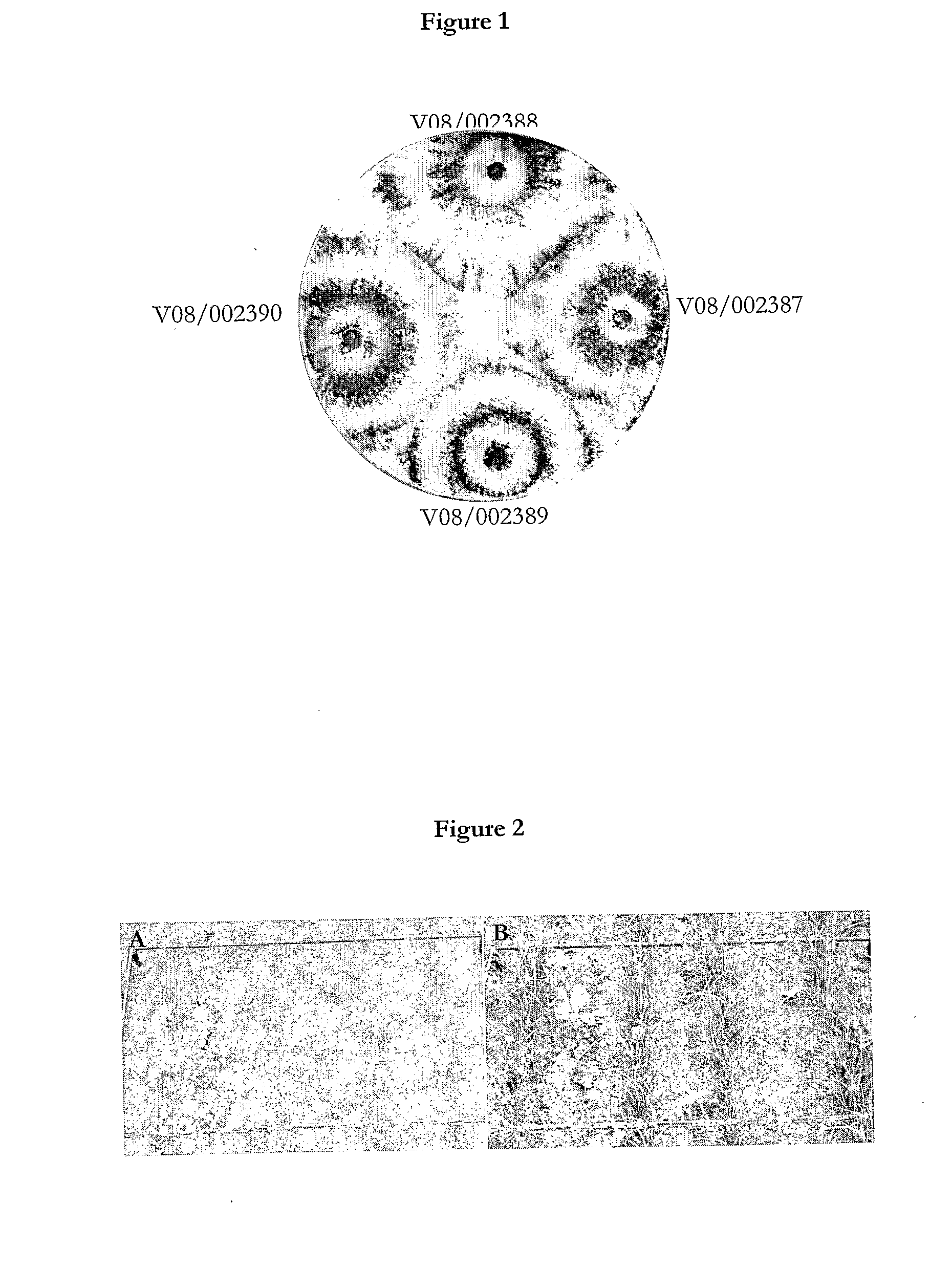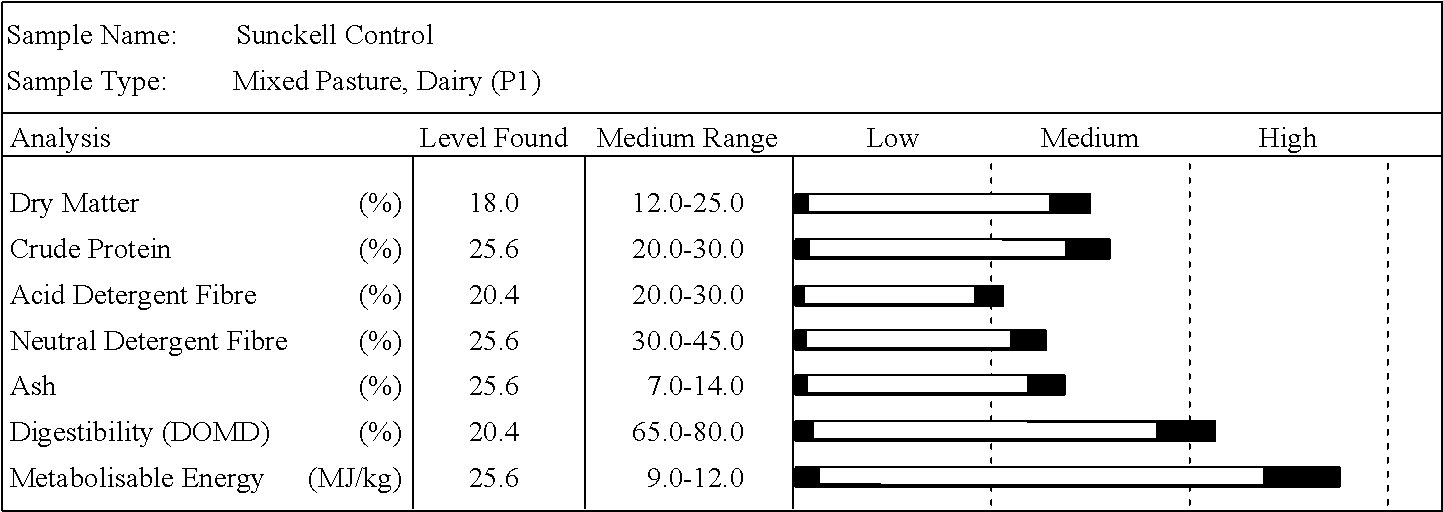Methods and compositions comprising trichoderma atroviride for the biological control of soil borne plant pathogens and promoting plant growth
a technology of trichoderma atroviride and composition, applied in the field of trichoderma atroviride, can solve the problems of increasing consumer concern about the effects of chemical residues on plants and the environment, plant disease represents a significant economic cost to modern agriculture, and the ecologically unbalanced system is susceptible to diseas
- Summary
- Abstract
- Description
- Claims
- Application Information
AI Technical Summary
Benefits of technology
Problems solved by technology
Method used
Image
Examples
example 1
Process for Selection of Pasture Seed Additive Biocontrol Agents
Introduction
[0108]Many isolates of the fungal species Trichoderma have been well characterised as biocontrol agents of soil-borne plant diseases. At Lincoln University, over 200 strains of Trichoderma have been isolated and identified from New Zealand agricultural and horticultural environments. Selection of Trichoderma biocontrol agents (BCA) from within the Lincoln University restricted collection for the biocontrol application was initially achieved by dual culturing with the target pathogen. 102 isolates of Trichoderma spp. were screened against three soil-borne pasture pathogens (Rhizoctonia solani, Sclerotinia trifoliorum and Pythium ultimum) to identify candidates for incorporation into a Pasture Seed Additive. Potential Trichoderma spp. candidates were then screened in planta for compatibility, biocontrol activity and plant growth promotion using three pasture disease complexes (perennial ryegrass vs R. solani, ...
example 2
Trichoderma atroviride (NMI No. V08 / 002388, NMI No. V08 / 002387, NMI No. V08 / 002389 and NMI No. V08 / 002390)
[0153]The T. atroviride strains were isolated from three separate locations in New Zealand. NMI No. V08 / 002388 and NMI No. V08 / 002387 were isolated from soil in Pukekohe, Auckland, New Zealand, respectively. NMI No. V08 / 002389 was isolated from a Ciborinia camelliae sclerotium from the Botanical gardens in Wellington, New Zealand. NMI No. V08 / 002390 was isolated from soil in Canterbury, New Zealand.
Trichoderma atroviride Identification
[0154]All Trichoderma atroviride isolates contained within the Pasture Seed Additive (PSA) were identified on the basis of taxonomic sequence analysis. According to the length and composition of the nucleotide sequences of the Internal Transcribed Spacer (ITS) region of the ribosomal gene cluster, the T. atroviride isolates are defined by 100% identity to the sequence AF456920 in the database GenBank (http: / / www.ncbi.nlm.nih.gov / ) of the strain DAO...
example 3
A Preparation of Trichoderma spp. for Pot and Field Experiments
[0157]Storage cultures of conidia from T. atroviride isolates NMI No. V08 / 002388, NMI No. V08 / 002387, NMI No. V08 / 002389 and NMI No. V08 / 002390 were preserved in 20% glycerol at −80° C. until required.
[0158]In all pot trials, a mixture of 0.5% (w / w) wheat bran inoculum to potting-mix was used. Wheat bran inoculum was prepared as follows: A 1 L conical flask was ¼ filled with dry wheat bran and distilled water added to make it wet and then autoclaved at 121□ C for 15 min at 15 p.s.i. The conical flasks were then inoculated with Trichoderma spp. agar plugs from the colony margin of 2 day old cultures grown on potato-dextrose agar (PDA) and incubated at 20° C. (12 h light / 12 h dark) for 14 days. Flasks were thoroughly shaken every two days to produce uniform inoculum.
B Preparation of Composition
[0159]In all field trials, Pasture Seed Additive (PSA) was used as the Trichoderma inoculum. The composition was formulated by Agri...
PUM
| Property | Measurement | Unit |
|---|---|---|
| pH | aaaaa | aaaaa |
| pH | aaaaa | aaaaa |
| pH | aaaaa | aaaaa |
Abstract
Description
Claims
Application Information
 Login to View More
Login to View More - R&D
- Intellectual Property
- Life Sciences
- Materials
- Tech Scout
- Unparalleled Data Quality
- Higher Quality Content
- 60% Fewer Hallucinations
Browse by: Latest US Patents, China's latest patents, Technical Efficacy Thesaurus, Application Domain, Technology Topic, Popular Technical Reports.
© 2025 PatSnap. All rights reserved.Legal|Privacy policy|Modern Slavery Act Transparency Statement|Sitemap|About US| Contact US: help@patsnap.com



